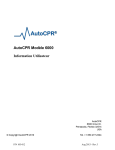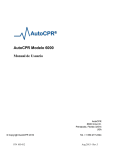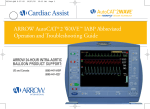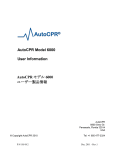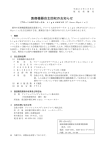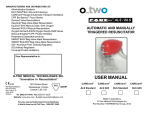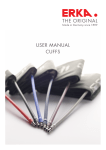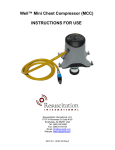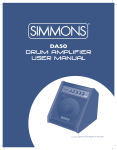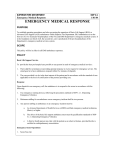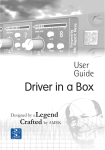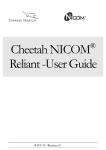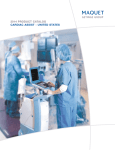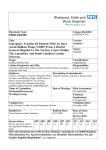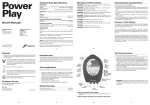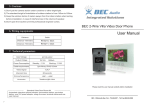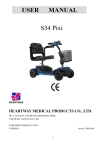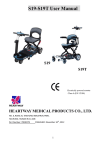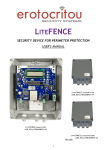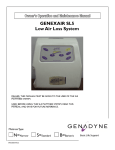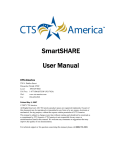Download user manual - AutoCPR
Transcript
P/N 105-012 Nov. 2013 - Rev.4 AutoCPR Model 6000 AutoCPR User Information The following user instructions for the AutoCPR Model 6000 must be read prior to using AutoCPR. The device is for use by CPR certified care providers as an adjunct to manual CPR. Always follow user instructions and contact an AutoCPR representative if user instructions are not understood. This device may be purchased only on the order of a licensed physician or medical practitioner. The manufacturer will make available on request circuit diagrams, component part lists, descriptions, calibration instructions, or other information that will assist service personnel to repair those parts of the AutoCPR Model 6000 that are designated by the manufacturer as repairable by service personnel. AutoCPR® is a registered international trademark. Declaration of Conformity AutoCPR complies with the requirements of the European Medical Device Directive 93/42/EEC. 0120 Copyright AutoCPR 2010 AutoCPR 8800 Grow Dr. Pensacola, Florida 32514 USA Authorized Representative Sébastien Vandamme 76 rue Colette 76620 Le Havre, France Tel. +1 850 477-2324 Tel. +33 6 43 90 70 65 P/N 105-012 Nov. 2013 - Rev.4 Table Of Content Safety Precautions......................................................................................... 1 Warning ................................................................................................ 1 Caution.................................................................................................. 2 Symbols .......................................................................................................... 3 1.0 2.0 3.0 4.0 5.0 6.0 7.0 Introduction ........................................................................................ 5 1.1 Indications for use ...................................................................... 5 1.2 Contraindications ....................................................................... 5 1.3 Description ................................................................................. 5 AutoCPR Components ....................................................................... 5 2.1 Controller ................................................................................... 6 2.2 Oxygen Ventilator ...................................................................... 6 2.3 Timer Assembly ......................................................................... 6 2.4 Air Supply .................................................................................. 6 2.5 Oxygen Supply ........................................................................... 6 2.6 Patient Kit................................................................................... 6 2.7 Patient Platform .......................................................................... 7 2.8 Battery Charger .......................................................................... 8 User Controls and Indicators ............................................................ 9 3.1 Oxygen and Air Connections ..................................................... 9 3.2 On/Off Power Button ................................................................. 9 3.3 Patient Airway Pressure Gauge.................................................. 9 3.4 Oxygen Ventilator .................................................................... 10 3.5 Ventilator Volume Selector...................................................... 10 3.6 Oxygen Ventilator Outlet ......................................................... 10 3.7 Control Selectors ...................................................................... 10 Using AutoCPR ................................................................................. 11 4.1 Preparing AutoCPR for Use ..................................................... 11 4.2 AutoCPR Operating Procedure ................................................ 12 4.3 AutoCPR in Operation ............................................................. 16 Return of Spontaneous Circulation ................................................ 16 Completion of Resuscitation Procedures ....................................... 17 6.1 Cleaning After Use ................................................................... 17 6.2 Preparing for Next Use............................................................. 17 AutoCPR Maintenance .................................................................... 18 7.1 Battery Replacement ................................................................ 19 P/N 105-012 Nov. 2013 - Rev.4 8.0 Tables: Performance Specifications – AutoCPR .......................... 20 Table 1-1 Compression Cuff Sizing ................................................... 20 Operating Parameters ........................................................ 20 Table 1-2 Physical Specifications ...................................................... 20 Table 1-3 Environmental Specifications ............................................ 20 Table 1-4 Fuse Specification .............................................................. 21 Table 1-5 Performance Specifications – Battery................................ 21 Table 1-6 Environmental Specifications – Battery ............................ 21 Table 1-7 Performance Specifications –Battery Charger................... 21 Table 1-8 Environmental Specifications –Battery Charger ............... 22 Table 1-9 Technical Specifications – Medical Oxygen Supply ......... 22 Table 1-10 Technical Specifications – Air Supply ............................ 22 Table 1-11 AutoCPR System Check List ........................................... 23 Table 1-12 AutoCPR Parts List .......................................................... 24 P/N 105-012 Nov. 2013 - Rev.4 Safety Precautions Safety precautions are indicated throughout the user instructions manual by the bold legends, Warning or Caution. The Warning legend alerts the user to avoid a possible hazardous situation which may result in serious injury or death. The Caution legend alerts the user of a possible hazardous situation which could result in injury and is to be avoided. Warning • AutoCPR is to be used only by persons trained in manual CPR • Do not use AutoCPR on patients less than 18 years of age • Do not use AutoCPR on patients with chest or abdomen wounds • Do not use AutoCPR if the patient is pregnant • Do not use AutoCPR if the patient is too small or too large • Always attend to patient during operation of AutoCPR • During automatic ventilations, if patient airway pressure rises above 55cmH2O or • • • • • • • • if patient valve alarm sounds, check patient airway for obstruction Clear patient airway before resuming automatic ventilations Prevent contaminants from entering air and oxygen connections If system components do not function according to user manual instructions, turn off controller air and oxygen supplies, press OFF power button, open chest cuff and resume manual CPR If empty air supply cylinders cannot be replaced immediately, open chest cuff and resume manual CPR. Press power button OFF and disconnect components Do not charge battery in wet areas Do not charge the battery while operating the AutoCPR Do not perform AutoCPR maintenance while operating the AutoCPR Warning: No modification of this equipment is allowed P/N 105-012 1 Nov. 2013 - Rev.4 Caution • The patient platform is not intended to be used for transporting or carrying • • • • • • • • • • • • • • • patients When transporting the patient the platform should be attached securely onto a backboard, gurney or other medical transportation means Securing straps must not interfere with patient compression cuffs or hoses Use only accessories included in the user instructions manual Do not allow liquids, dirt or sand to enter the AutoCPR controller The battery is to be recharged after use or within twelve hours after the low battery warning light begins flashing to prevent permanent battery damage Follow all operating instructions in the user manual Apply compression cuffs tightly around patient chest, abdomen and legs Do not cut or puncture patient compression cuffs During operation of the AutoCPR controller, if the low battery light begins flashing, the controller will operate for an additional 45 minutes The AutoCPR Patient Kit is for single use only. Used components are to be treated as contaminated medical waste and disposed of as required by local authority Do not re-use AutoCPR Patient Kit. Re-use of single use Patient Kit may result in inadequate cleaning and decontamination, residues from decontamination agents, cross-contamination, material alteration, and/or device failure Do not use AutoCPR Patient Kit if packaging seal has been opened or if packaging has been damaged Use only AutoCPR approved accessories. Use of non-AutoCPR accessories will result in ineffective operation. Use only AutoCPR battery charger supplied with the unit. Other type battery chargers may incorrectly charge and damage battery possibly resulting in injury to operating personnel. If an air compressor is used to inflate compression cuffs, the compressor air supply temperature is to be monitored and is not to exceed 41°C. P/N 105-012 2 Nov. 2013 - Rev.4 AutoCPR Symbols Symbols located throughout the user manual, on the controller and patient kit conform to EN Standards. Their use reduces the need for translations of words into national languages. Automatic Operating Position Airway Pressure Measurement Single Use Only – Do Not Reuse Ventilator Operating Instructions Date of Manufacture ON/OFF ON OFF Type BF Patient Connection P/N 105-012 3 Nov. 2013 - Rev.4 Serial Number O2 Oxygen Supply AIR Air Supply Manufacturer Authorized Representative DC Input P/N 105-012 4 Nov. 2013 - Rev.4 1.0 Introduction Current methods of cardiopulmonary resuscitation require manual or mechanical devices to provide chest compressions and airway management and often a ratio of three care providers to one patient is required. In a hospital environment this is a significant physical demand, but in the pre-hospital setting this effort often yields unfortunate results. Under optimal conditions, circulation and ventilation requirements are fatiguing labors for care providers. The AutoCPR device assumes both of these functions and once started provides automatic, uninterrupted cardiopulmonary resuscitation. AutoCPR combines external chest compressions synchronized with external counterpulsation to provide forward blood flow hemodynamically. Integrated into the device is a time cycled and pressure limited oxygen ventilator for pulmonary resuscitation. 1.1 Indications for use AutoCPR is for use on adult patients only as an adjunct to manual cardiopulmonary resuscitation in cases of clinical death as defined by lack of spontaneous breathing and pulse. 1.2 • • • • • 1.3 Contraindications Patients under 18 years of age Patients with chest or abdominal wounds Pregnancy Patient too small Patient too large Description AutoCPR is a portable system for use by emergency medical teams or other first responders as an adjunct to manual CPR. It combines into a single resuscitation system: • External chest compressor • External counterpulsation to provide forward blood flow hemodynamically • Oxygen ventilator 2.0 • • • • • AutoCPR Components Controller Air supply hose with unique connector Oxygen supply hose with unique connector Patient Kit (patient-contacting) Battery Charger P/N 105-012 5 Nov. 2013 - Rev.4 2.1 Controller The AutoCPR controller utilizes a source of compressed oxygen for patient ventilation and compressed air to cyclically inflate legs, abdomen and chest compression cuffs to provide cardiopulmonary resuscitation by inducing circulation in patients clinically dead as defined by lack of spontaneous breathing and pulse. The portable controller assembly provides inflation cuff sequence, pressure and cycle rate. An oxygen ventilator integrated into the controller provides uninterrupted pulmonary resuscitation in proper timing with cuff inflations. 2.2 Oxygen Ventilator The oxygen ventilator includes a ventilator volume selector and demand breathing regulator. The ventilator outlet connects to the oxygen delivery tube, patient valve and mask. 2.3 Timer Assembly The automatic function of AutoCPR is controlled by an electronic timer assembly powered by a small battery. 2.4 Air Supply The AutoCPR controller receives pressure reduced air from a wall outlet, air compressor or portable compressed air cylinder. The air supply hose has a unique female connector that fits only the male air connector on the controller. The opposite end of the supply hose is connected to the pressure reduced air supply. (Reference Table 1-10 for specifications of regulated air supply sources) 2.5 Oxygen Supply The AutoCPR controller receives pressure reduced medical oxygen from an oxygen cylinder or wall outlet. The oxygen supply hose has a unique female connector that fits only the male oxygen connector on the controller. The opposite end of the supply hose is connected to the pressure reduced oxygen supply. (Reference Table 1-9 for specifications of regulated oxygen supply sources) 2.6 Patient Kit The patient kit includes the following type B applied parts: • Patient platform • Compression cuffs: chest, abdomen and leg cuffs • Cuff hoses with non-interchangeable and color coded connectors • Oxygen delivery tube, patient valve assembly and mask The patient kit is defibrillation-proof and can be used in conjunction with an AED. P/N 105-012 6 Nov. 2013 - Rev.4 2.7 Patient Platform AutoCPR, latex free compression cuffs are attached to the patient platform in a ready position for immediate application. The platform aids medical professionals when applying the compression cuffs to the patient. The cuffs have inflatable bladders that are held in place on the patient by straps with hook and loop fasteners. Leg cuffs are applied to the thigh of each leg and secured with hook and loop fastened straps. Color coded and non-interchangeable hose connectors mate with corresponding connectors on cuffs and system controller. During AutoCPR operation, cuffs cycle sequentially; first the legs followed by the abdomen and then the chest. Chest and abdomen cuffs cycle in counter phase at a combined rate of sixty compressions a minute. Leg cuffs cycle at a rate of five compressions a minute. Table 1-1 Compression Cuff Sizing Chest circumference Abdomen circumference Leg/thigh circumference Maximum patient weight 64cm to 145cm 66cm to 145cm 36cm to 66cm 136 kg Warning: The platform is not intended to be used for transporting or carrying patients. When transporting the patient, the platform should be attached securely onto a backboard, gurney or other medical transportation means. Securing straps must not interfere with patient cuffs and hoses. P/N 105-012 7 Nov. 2013 - Rev.4 2.8 Battery Charger The controller battery is the internal power supply for AutoCPR and is connected to the electronic system. The battery is recharged in place with the external charger. The battery charger is connected to the DC input on the back side of the controller case. The battery charger cord must be plugged into a 220 VAC/50Hz wall socket. (Reference Tables 1-5 and 1-6 for battery specifications) The battery charger is not intended to be used during AutoCPR operation. The battery should be fully charged before using and will run the AutoCPR unit for sixty minutes before the low battery indicator turns on. Use only AutoCPR battery charger supplied with unit. Caution – Low Battery A red LED low battery warning light is located on the front side of the case. When the red warning light starts flashing, the battery will operate the unit for 45 minutes. Start battery recharge within twelve hours of the initial low battery warning to avoid permanent damage to the battery. P/N 105-012 8 Nov. 2013 - Rev.4 3.0 User Controls and Indicators User controls and indicators are positioned on the AutoCPR controller panel. On/Off Button Airway Pressure Ventilator Volume Selector Ventilator Outlet Oxygen Supply Air Supply Chest Cuff Connection Off/Chest Cuff Automatic/Chest Cuff Abdomen Cuff Connection Leg Cuffs Connection Off/Abdomen Cuff Automatic/Abdomen Cuff Off/Leg Cuffs 3.1 On/Leg Cuffs Automatic/Leg Cuffs Oxygen and Air Connections O2 ¯ AIR Oxygen and air supply connections on the AutoCPR controller have unique connection means that are non-interchangeable. 3.2 On/Off Power Button The ON/OFF power button is located at the top left corner of the controller. A green LED in the middle of the button lights when in the ON mode. When the button is pressed a second time the AutoCPR controller ceases operation and the light turns Off. 3.3 Patient Airway Pressure Gauge A gauge measures patient airway pressure during automatic oxygen ventilation. The gauge has graduates of 0 to 75 cmH2O. Warning: • During automatic oxygen ventilation if airway pressure rises above 55 cmH2O or if patient valve alarm sounds, check patient airway for obstruction. • Clear patient airway before resuming automatic ventilation P/N 105-012 9 Nov. 2013 - Rev.4 3.4 Oxygen Ventilator The oxygen ventilator has two modes of operation: Automatic and Demand • The Automatic setting is controlled by the ventilator volume selector and is used during resuscitation. • The Demand setting is also controlled by the ventilator volume selector and is used when the resuscitated patient is spontaneously breathing. 3.5 Ventilator Volume Selector The ventilator volume selector has four positions for levels of patient tidal volume and one Demand position for patient spontaneous breathing. Each position is calibrated for a flow that when matched with the electronic timer allows for a fixed volume of oxygen to flow to the patient. The patient ventilator is time cycled and pressure limited. The ventilator automatically cycles in phase with every second abdomen cuff compression to reduce the possibility of gastric insufflation and pulmonary aspiration of gastric contents. Patient oxygen ventilation is selectable at 400, 600, 800 or 1000 milliliters for each cycle. The proper ventilator volume setting is determined by multiplying the patient weight by 8-10 ml. /kg. If the resuscitated patient requires additional oxygen flow, the demand feature of the ventilator provides additional flow to meet patient demand. 3.6 Oxygen Ventilator Outlet The oxygen ventilator has a standard 22mm outlet connection for the oxygen delivery tube, patient valve assembly and mask. The 22mm outlet is a unique male connector for the oxygen delivery tube. The patient valve assembly includes an alarm whistle that sounds a tone when pressure in the outlet exceeds 55 cmH2O 3.7 Control Selectors Compression cuff control selectors are located in the center of the AutoCPR control panel and their operating positions are marked with the following symbols: Automatic position Off position On position P/N 105-012 10 Nov. 2013 - Rev.4 • • • The Chest Cuff Control Selector has two positions: o Automatic o Off The Abdomen Cuff Control Selector has two positions: o Automatic o Off The Leg Cuffs Control Selector has three positions: o Automatic o Off o On § The leg cuff ON position is for use when the patient has wounds to the leg(s). 4.0 Using AutoCPR Warning • For use only on patients 18 years of age or older • For use by CPR certified care providers as an adjunct to manual CPR • Not to be used on patients that are pregnant • Not to be used on patients with chest or abdominal wounds • Not to be used on patients too small or too large 4.1 Preparing AutoCPR for Use Before using AutoCPR the controller should be set to the following positions: • Oxygen Ventilator Volume Selector set to the 600 milliliter position • Chest Cuff Selector set to the Automatic position • Abdomen Cuff Selector set to the Automatic position • Leg Cuffs Selector set to the Off position P/N 105-012 11 Nov. 2013 - Rev.4 4.2 AutoCPR Operating Procedure The following procedure for operating the AutoCPR resuscitation system requires two persons trained and certified in cardiopulmonary resuscitation • Remove patient kit from its protective bag. • After determining the condition of the patient, set the patient in the upright position • Place the platform with the attached chest and abdomen cuffs behind the patient with person symbol pointing in the direction of the patient’s head P/N 105-012 12 Nov. 2013 - Rev.4 • Rapidly pull cuff lanyard completely away from platform to expose abdomen and chest cuffs in ready position • Lay patient’s back onto the platform • Alternately, place the platform and cuffs to the patient’s side and roll the patient’s back onto the platform. P/N 105-012 13 Nov. 2013 - Rev.4 • First attendant: o Apply chest cuff tightly around patient directly below the armpits with center of cuff above sternum. Secure fasteners. o Apply abdomen cuff tightly around patient and with center of cuff above abdomen. Secure fasteners. o Do not place cuff around patient stomach o Connect blue hose connector to chest cuff o Connect yellow hose connector to abdomen cuff Defibrillator pads will not effect operation of AutoCPR chest cuff • Second attendant: o Connect air supply hose to AutoCPR controller § Turn On air supply valve o Connect oxygen supply hose to AutoCPR controller § Turn On oxygen supply valve P/N 105-012 14 Nov. 2013 - Rev.4 o Connect (blue) chest cuff hose to controller o Connect (yellow) abdomen cuff hose to controller o Connect oxygen delivery hose with patient valve and mask to ventilator outlet on controller o Press ON/OFF power button on controller – green indicator lights o Apply oxygen mask to patient airway P/N 105-012 15 Nov. 2013 - Rev.4 • 4.3 First attendant: o Apply leg cuffs tightly around each leg close to the groin o Connect (red) legs cuff hose to controller o Turn Leg cuff selector to Automatic AutoCPR in Operation With Cuff Selectors set to the Automatic positions and ventilator volume selected, the controller provides inflation cuff sequence, pressure, and cycle rate and oxygen ventilation. 5.0 • • Return of Spontaneous Circulation Upon return of spontaneous circulation: o Turn Chest Cuff Selector to OFF position o Disconnect chest cuff hose from controller o Continue to cycle abdomen and leg cuffs to provide circulation support o Continue to cycle oxygen ventilator o If patient begins spontaneous breathing, turn ventilator volume selector to the Demand setting If patient returns to cardiac arrest: o Connect chest cuff hose to controller o Turn Chest Cuff Selector to ON position o Turn Ventilator Volume Selector to the appropriate volume setting P/N 105-012 16 Nov. 2013 - Rev.4 6.0 • Completion of Resuscitation Procedures Upon completion of resuscitation procedures: o Press ON/OFF power button – green indicator light turns off and automatic cuff cycles and oxygen ventilation cycles cease. o Remove oxygen mask from patient airway o Turn OFF chest, abdomen and leg cuff selectors o Disconnect chest, abdomen and leg cuff hoses from controller o Open chest, abdomen and leg cuff fasteners o Turn off air supply and disconnect from controller o Turn off oxygen supply and disconnect from controller Caution • Patient platform, tubing, compression cuffs, oxygen delivery tube, valve and mask are for single use only. • Single use components are to be treated as contaminated medical waste and disposed of as required by local authority 6.1 • • 6.2 • • • • • • • Cleaning After Use Clean all exposed surfaces of the AutoCPR controller with a cloth and isopropyl alcohol or other disinfectant. Allow cleaned surface to completely dry before closing the case Preparing for Next Use Pre-set the controls to the following positions: o Oxygen Ventilation Volume Selector set to the 600 ml. position o Chest Cuff Selector set to the Automatic position o Abdomen Cuff Selector set to the Automatic position o Leg Cuff Selector set to the OFF position Select new patient kit The controller battery is recharged by connecting the battery charger to its connection on the back side of the case and plugging the cord into a 220VAC/50Hz electrical outlet. The battery charger will maintain the battery in a ready position if connected when the controller is not in use. Use only AutoCPR battery charger supplied with unit. The battery, if not connected to the battery charger, will maintain a full charge for 60 hours (with unit off) before low battery indicator lights. A flashing red low battery indicator light on the front of the case indicates the battery requires recharging. Battery charging must be started within 12 hours after the flashing indicator lights to prevent permanent damage to the battery. P/N 105-012 17 Nov. 2013 - Rev.4 Caution If the low battery indicator light remains flashing after four hours of charging, do not use the AutoCPR and contact the manufacturer or local service technician for maintenance. 7.0 • AutoCPR Maintenance After use cleaning and replacement of the battery are the only user maintenance items in AutoCPR • Maintain controller assembly connected to battery charger when not in use • If the low battery warning light does not turn off after four hours of battery charging or if device does not operate according to user manual instructions, contact the local AutoCPR technician or manufacturer. In addition to after use cleaning, the device should be inspected weekly or more frequently if used several times monthly. Reference: Table 1-11 for AutoCPR system check list. The internal battery must be replaced after 100 use cycles or annually, whichever occurs first. See manual instructions for battery replacement. Servicing of the AutoCPR controller is recommended every five years. If the controller does not operate according to manual instructions do not use and contact the manufacturer or local servicing technician for maintenance. User preventive maintenance • Inspect all inlet and outlet connections on AutoCPR controller for contaminants • Check the operation of control valves, oxygen selector and ON/OFF power button • Check that the battery charger is connected to the controller and plugged into a wall socket when the device is not in use • Inspect the controller and case for apparent physical damage • Check that an unopened patient kit is accessible • Check patient kit label for expiration date. Do not use if kit has expired date. Factory maintenance • Return AutoCPR controller to service center or manufacturer if it does not operate according to User Manual. • AutoCPR controller should be returned to service center or manufacturer for maintenance after five years of service time Warning Unless specified otherwise, repairs and servicing must be carried out by AutoCPR approved service technicians. Failure to follow these conditions may lead to patient/operator injury or death. P/N 105-012 18 Nov. 2013 - Rev.4 7.1 Battery Replacement • • • • • • • • • • • P/N 105-012 Open controller case and remove four panel screws Lift panel and disconnect cable from panel assembly Remove controller panel from case Disconnect battery cable Remove four screws from battery box cover Remove battery box cover and battery Insert new battery and connect cable Replace battery box cover and fasten with four screws Connect cable to panel assembly Set in place controller panel and fasten with four screws Press power button and check for green indicator light 19 Nov. 2013 - Rev.4 8.0 Performance Specifications – AutoCPR Table 1-1 Patient Size Chest circumference Abdomen circumference Leg/Thigh circumference Maximum patent weight Operating Parameters Sternal depression Sternal depression force Compression sequence Total compression rate Total duty cycle Oxygen ventilation Oxygen ventilation sequence Specifications 64cm to 145cm 66cm to 145cm 36cm to 66cm 136 kg Specifications 4cm to 5cm 45 kg Legs – abdomen – chest 65 continuous 65 continuous Automatic – 15 ventilations/minute Phased w/ each 2nd abdomen compression Table 1-2 Physical Specifications Controller Patient kit Dimensions 48 x 36 x 18 cm 91 x 41 x 15 cm Weight 8.6 kg 3.5 kg Table 1-3 Environmental Operating temperature Storage temperature Relative humidity Safety classification Specifications 0ºC to +45ºC 0ºC to +45ºC 5% to 95%, non-condensing Meets EN 60601, internally powered, Type BF, movable, short time operation, 60 minutes IP Classification IP20 Electromagnetic Susceptibility Meets EN 61000-4-3,4,5 and 6 RF Emissions Device uses or produces no RF energy for its internal function Electrostatic Discharge Meets EN 61000-4-2 Electromagnetic Radiated Immunity Meets EN 61000-4-3 Electromagnetic Conducted Immunity Meets EN 61000-4-6 10Vrms Corrosion resistance External components non-corrosive Operating Classification Short time EN 60601-1, 60 minutes AutoCPR is suitable for use in all buildings including the home, commercial or hospital environment and meets the requirements of EN 60601-1-2. Susceptibility can not be assured outside of this environment P/N 105-012 20 Nov. 2013 - Rev.4 Table 1-4 Fuse Specification Description: Battery and charger fuses mounted to Controller circuit board Fuse Type: Resettable PTC – not user serviceable Mounting Type: Surface Mount Voltage – Rated: 13.2 VDC Current: 500mA Operating Temperature: -40°C to +85°C Approvals: UL File No. E183209, TUV File No. R50082521 Table 1-5 Performance Specifications – Battery Battery Battery type Battery make and model Size: (L x W x H) Weight Nominal voltage Nominal capacity Nominal operating time/charged Battery charge time Battery replacement Specifications Rechargeable sealed lead acid battery Power Sonic PS-1208 96 x 25 x 62 mm 0.36 kg 12 volts 0.80 AH +60 minutes 4 hours 100 cycles or 1 year Table 1-6 Environmental Specifications – Battery Battery Operating temperature range Charge temperature range Storage temperature range Operating altitude Specifications 0ºC to +45ºC +5ºC to +35ºC 0ºC to +45ºC 3,050 meters Table 1-7 Performance Specifications –Battery Charger Battery Charger Battery charger type Model Number Size: (L x W x H) Weight Operating voltage Operating frequency Voltage output Insulation class Battery Charge Fuses P/N 105-012 Specifications Lead acid charger, WPI, 1.3 A 452241-SB 121 x 76 x 57mm 0.70 kg 230 VAC 50 Hz 13.8 Vdc @ 290 mA Class II 4 hours Auto reset thermal breaker 21 Nov. 2013 - Rev.4 Table 1-8 Environmental Specifications –Battery Charger Battery Charger Operating temperature Storage temperature Relative humidity Safety requirements Electromagnetic emissions Harmonic emissions Voltage fluctuations/flicker emissions Electrostatic discharge Electromagnetic immunity Electrical fast transient/burst Surge Power frequency (50/60 Hz) magnetic field Voltage dips, short interruptions and voltage variations on power supply input lines Specifications 0ºC to +40ºC 0ºC to +45ºC 5% to 95% non-condensing Meets UL60601-1 & CE LVD EN60601-1 Meets EN 55011 Group1, Class A Meets EN 61000-3-2 Meets EN 61000-3-3 Meets EN 61000-4-2 Meets EN 61000-4-3 and -6 Meets EN 61000-4-4 Meets EN 61000-4-5 Meets EN 61000-4-8 Meets EN 61000-4-11 Table 1-9 Technical Specifications – Medical Oxygen Supply Pressure Regulators or Wall Outlet Minimum Pressure: 3.5 bar Nominal Pressure: 4.0 bar Maximum Pressure: 5.0 bar Minimum Flow Rate: 50 liters/minute Table 1-10 Technical Specifications – Medical Grade/Breathing Quality Air Pressure Regulators or Wall Outlet Minimum Pressure: 4.5 bar Nominal Pressure: 5.0 bar Maximum Pressure: 8.0 bar Minimum Flow Rate: 75 liters/minute P/N 105-012 22 Nov. 2013 - Rev.4 Table 1-11 AutoCPR System Check List Date: Operational status of AutoCPR should be checked weekly as follows: Inspection List Inspector Comments All exposed surfaces clean Ventilator volume set to 600 ml Chest cuff selector set to automatic position Abdomen cuff selector set to automatic position Leg cuff selector set to Off position Battery charger connected Test function of power On button – LED lights Low battery indicator light is Off Inspect inlet and outlet connectors for contaminants Inspect AutoCPR controller for physical damage Connect air supply hose to controller and functionally test the controller Connect oxygen supply hose to controller and functionally test ventilator Check for accessible patient kit P/N 105-012 23 Nov. 2013 - Rev.4 Table 1-12 AutoCPR Parts List Part Description AutoCPR Controller Patient Kit Patient Kit (For Training Use Only) Air Supply Hose with Connector Oxygen Supply Hose with Connector Battery Charger Battery P/N 105-012 Part Number 200-018 215-051 215-053 215-059 215-060 170-008 170-004 24 Nov. 2013 - Rev.4




























